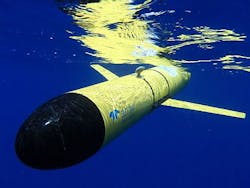NOAA asks industry for long-endurance UUV to profile ocean temperatures and salinity
STENNIS SPACE CENTER, Miss., 21 Aug. 2013. Researchers at the U.S. National Oceanic and Atmospheric Administration (NOAA) are asking industry to provide a long-endurance unmanned underwater vehicle (UUV) to conduct ocean temperature and salinity tests.
The NOAA National Data Buoy Center at Stennis Space Center, Miss., last Friday issued a solicitation (NWWG9502-13-03082) for a profiling glider -- a long-endurance unmanned submersible able to operate over vast ocean areas for months at a time while using a minimum of electric power.
A UUV sea glider uses variable ballast to control its depth in the ocean. It works by rising to the surface, adjusts its ballast to make it sink, and then uses control surfaces to propel itself forward and maneuver, in a similar way that a glider aircraft moves through the air.
The sea glider will gather ocean water data as part of the NOAA National Data Buoy Center's Hurricane and Tropical Atmosphere Ocean (TAO) project network to conduct temperature and salinity profiles.
Some sea gliders operate only on the surface, using the up-and-down motion of wave action to move a fin-like array that hangs beneath the surface craft.
Long-endurance sea gliders can navigate using a combination of inertial measurement units (IMU) and GPS receivers. When the glider rises to the surface it sticks an antenna out of the water to get its GPS position. It can track its position while submerged using its IMU and dead reckoning.
A variety of unmanned vehicle companies offer sea gliders that operate on the water or below the surface, including iRobot Corp. in Bedford, Mass.; Hydroid Inc. in Pocasset, Mass.; Kongsberg Maritime in Kongsberg, Norway; Bluefin Robotics in Quincy, Mass.; and Liquid Robotics Inc. in Sunnyvale, Calif.
From industry, officials of the NOAA National Data Buoy Center want a sea glider for water profiling that operates to depths of 1,600 feet while measuring ocean temperature and salinity, measures temperatures from -2 to 35 degrees Celsius, can remain at sea for as long as four months, and be compatible with the U.S. Navy Glider Monitoring, Piloting, and Communications (GLMPC) software.
The glider also must be able to communicate over the Iridium satellite communications network, include vendor training, be able to be deployed and recovered in environments as severe as sea state 2, have an internal clock with no more than 10 seconds drift over mission deployment, and have GPS navigation with accuracy of at least 20 meters.
Companies interested should submit offers by email to NOAA's Linda Mullen by email at [email protected], or in writing care of the Eastern Region Acquisition Division, 200 Granby St., Room 815, Norfolk, Va. 23510.
For questions or concerns contact NOAA's Linda Mullen by phone at 757-441-3436, by fax at 757-664-3649, or by email at [email protected].
More information is online at https://www.fbo.gov/spg/DOC/NOAA/EASC/NWWG9502-13-03082/listing.html.
For additional information contact the National Data Buoy Center at www.ndbc.noaa.gov, or the Tropical Atmosphere Ocean Project at www.pmel.noaa.gov/tao.

